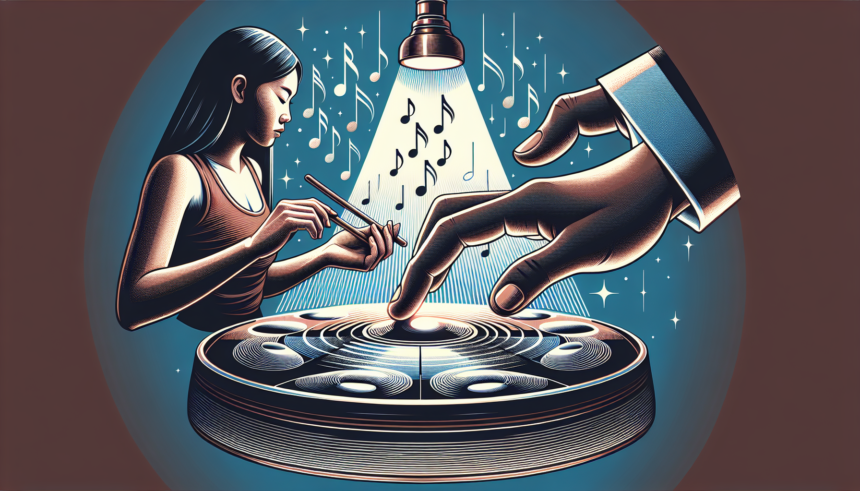<!DOCTYPE html>
<html lang="en">
<head>
<meta charset="UTF-8">
<meta name="viewport" content="width=device-width, initial-scale=1.0">
<title>Understanding Syncopation in Handpan Performance</title>
<style>
body {
font-family: Arial, sans-serif;
line-height: 1.6;
margin: 20px;
color: #333;
}
h2 {
color: #4A90E2;
}
ul {
list-style-type: disc;
margin-left: 20px;
}
</style>
</head>
<body>
<h1>Understanding Syncopation in Handpan Performance</h1>
<p>Syncopation, an essential rhythmic element in music, plays a critical role in enhancing musical expression and creating compelling performances. In the context of handpan playing, an understanding of syncopation can offer new dimensions to a player's creativity and musicality. This article delves deep into the concept of syncopation, specifically focusing on its application to handpan performance, discussing techniques, benefits, and offering insights into how it can elevate a performer's musical repertoire.</p>
<h2>What is Syncopation?</h2>
<p>At its core, syncopation involves the deliberate displacement of the expected rhythmical pattern, which often results in unexpected beats being emphasized. This can create a sense of movement and dynamism, and when applied effectively, it can transform simple musical phrases into engaging and memorable performances.</p>
<p>Typically, music has a regular rhythm, where beats are evenly spaced and predictable. Syncopation disrupts this regularity, infusing music with surprise by accenting beats that are usually unaccented or by creating a rest where a beat might be anticipated. It is an intentional deviation from the standard rhythm, offering a contrast that engages listeners.</p>
<h2>The Role of Syncopation in Handpan Performance</h2>
<p>The handpan, with its mesmerizing sound and percussive nature, is an ideal instrument for experimenting with syncopation. By introducing syncopation, a handpan player can exploit the full expressive potential of the instrument, enhancing the emotional impact of their music.</p>
<p>Syncopation in handpan performance can manifest in various ways:</p>
<ul>
<li><strong>Polyrhythms:</strong> Introducing different rhythms played simultaneously, creating a complex and engaging soundscape.</li>
<li><strong>Unexpected Accents:</strong> Placing accents on off-beats or weak beats to produce surprise and excitement in the rhythm.</li>
<li><strong>Rhythmic Displacement:</strong> Shifting rhythmic motifs or entire phrases to create tension and release.</li>
<li><strong>Pauses and Rests:</strong> Incorporating strategic silences that disrupt the rhythm, creating anticipation and resolution.</li>
</ul>
<h2>Techniques for Incorporating Syncopation</h2>
<p>Handpan players looking to incorporate syncopation into their performances can begin by exploring these techniques:</p>
<ul>
<li><strong>Practice with a Metronome:</strong> Start with a simple rhythmic pattern and slowly introduce syncopated elements while keeping time with a metronome. This helps in internalizing complex rhythms and maintaining accuracy.</li>
<li><strong>Explore Different Time Signatures:</strong> Experiment with various time signatures, such as 5/4, 7/8, or 9/8, which naturally lend themselves to syncopation due to their irregular beat division.</li>
<li><strong>Layer Patterns:</strong> Develop a base rhythm pattern and layer syncopated motifs on top. This layering can introduce a rich texture and complexity to the music.</li>
<li><strong>Focus on Dynamics:</strong> Use volume changes to accentuate syncopated beats. Dynamics can highlight syncopation by making accented notes stand out more.</li>
<li><strong>Improvise:</strong> Allow yourself the freedom to explore and experiment without restrictions. Improvisation is a powerful tool in discovering unique syncopated rhythms.</li>
</ul>
<h2>Benefits and Impact of Syncopation</h2>
<p>The incorporation of syncopation in handpan playing offers several benefits:</p>
<ul>
<li><strong>Enhanced Musicality:</strong> Syncopation adds a layer of depth and sophistication to music, making it more interesting and emotionally engaging.</li>
<li><strong>Improved Rhythmic Skills:</strong> Understanding and playing syncopated rhythms can enhance a musician's sense of timing and rhythmic accuracy.</li>
<li><strong>Greater Expressiveness:</strong> With syncopation, handpan players can tell a more compelling musical story, conveying mood and emotions effectively.</li>
<li><strong>Audience Engagement:</strong> The surprising elements of syncopation captivate listeners, keeping them attentive and interested.</li>
</ul>
<h2>Challenges to Consider</h2>
<p>While syncopation can greatly enhance performance, it presents certain challenges that musicians should be mindful of:</p>
<ul>
<li><strong>Complexity:</strong> Learning to play and master syncopated rhythms can be challenging, requiring discipline and persistent practice.</li>
<li><strong>Overuse:</strong> Excessive use of syncopation can detract from the music's overall effect, making it feel chaotic rather than compelling. Balance is key.</li>
<li><strong>Audience Reception:</strong> Not all audiences are accustomed to or appreciate syncopation, which may require adjusting the performance to match listeners' preferences.</li>
</ul>
<h2>Conclusion</h2>
<p>Syncopation, undoubtedly, is a powerful and transformative element in handpan performance. It challenges traditional rhythmic boundaries and offers new avenues for creative expression. Players who invest time in mastering syncopated rhythms will find that their music becomes more dynamic and engaging, offering both themselves and their audience an enriching auditory experience. By understanding the principles of syncopation and thoughtfully incorporating them into performances, handpan players can elevate their artistry and connect more deeply with their listeners.</p>
<h2>Frequently Asked Questions (FAQs)</h2>
<h3>1. What is the primary purpose of using syncopation in music?</h3>
<p>Syncopation is primarily used to create variety, complexity, and surprise in music. It serves to break the monotony of regular rhythms, engaging listeners by accenting unexpected beats and adding a sense of motion and excitement to the piece.</p>
<h3>2. Can beginners effectively use syncopation when learning to play the handpan?</h3>
<p>Yes, beginners can start incorporating simple syncopated patterns into their practice to develop their rhythmic skills. However, they should focus on mastering basic rhythms first to build a solid foundation before adding complexity.</p>
<h3>3. How can I practice syncopation on the handpan if I don't have access to formal lessons?</h3>
<p>There are many resources available online, including video tutorials and rhythm exercises that can help you learn syncopation independently. Practicing with a metronome and exploring different musical genres can also enhance your understanding of syncopation.</p>
<h3>4. What genres of music heavily rely on syncopation?</h3>
<p>Genres such as jazz, funk, Latin music, and reggae are well-known for their extensive use of syncopation. These genres often emphasize off-beats and employ complex, engaging rhythms that define their unique sounds.</p>
<h3>5. How does syncopation influence the listener's perception of music?</h3>
<p>Syncopation influences listeners by creating surprise and contrast, which can elicit emotional responses. The unexpected accents can pique interest, maintain attention, and evoke feelings ranging from excitement to anticipation in the audience.</p>
</body>
</html>Understanding Syncopation in Handpan Performance

Leave a comment




